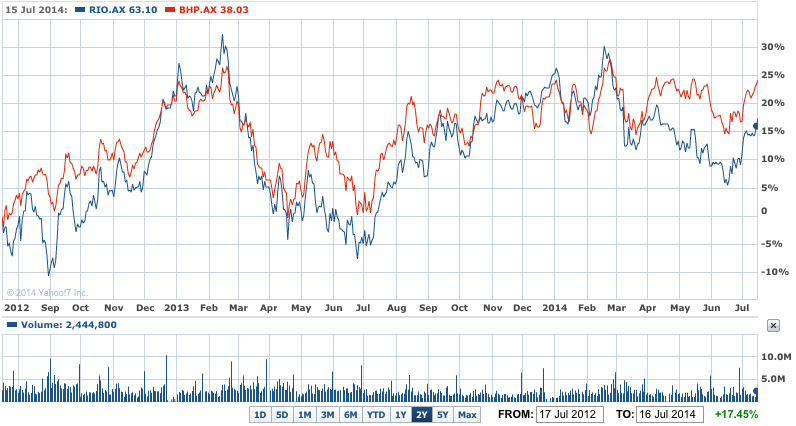Besides the full bore production and selling of its iron ore from its huge WA mines, Rio Tinto (RIO) has also revealed a considerable improvement in its copper business.
As well there was mixed, but on the whole positive news, on coal and from the company’s troubled aluminium business.
The miner may have left its iron ore production guidance for the year unchanged (despite a rise of around 11% in the six months to June), but it lifted its copper output guidance by 15%.
Rival BHP Billiton (BHP) releases its fourth quarter and full year figures next Wednesday and by all accounts will break its full-year production targets because of rising output from the new Jimblebar mine in WA.
Besides iron ore, also watch for BHP to match the upgrade from Rio for its copper business. Rio has a 27% interest in Escondida which BHP controls with a 57% stake.
BHP vs RIO 2Y – BHP to follow RIO with improved copper prospects?

Rio’s copper business now seems to be on the upswing after a couple of tough years, thanks mostly to weaker than expected demand and the huge cave in at its US Kennecott mine.
Now they seem to be back on line and new oputoput is flowing from the multi billion new mine in Mongolia.
The increased copper guidance for its share of full-year mined copper is now about 585,000 tonnes, up from 570,000. Refined copper production is forecast to rise to 300,000 tonnes, previously 260,000.
The increases flow from the rising output at the Mongolian mine Oyu Tolgoi and higher-than-expected grades at its Kennecott Utah Copper operations.
On top of this, Rio’s higher production (and BHP’s) has come as world copper prices have risen this year – up around 9% so far and in the range of $US3.25 to $US3.27 a pound this week.
That’s despite fears about an overhang of metal stocks in China and a surplus of production over demand.
But while the news was good from iron ore and copper, Rio’s coal business is struggling, like so many of its competitors.
Rio lowered its guidance for coking coal production by almost 10%, from 8.2 million tonnes to 7.4 million tonnes.
For that reason it will be interesting to see what BHP says about its coal business, which is far larger than Rio’s and more focused on coking (metallurgical) coal used in the steel industry.
Rio’s guidance cut though is due in part to the deliberate decision to produce more thermal coal at the Hail Creek mine in central Queensland, because it earns higher margins than the coking coal at that mine.
Rio also blamed the slower than forecast production ramp up at the newish Kestrel mine near Emerald in Queensland.
As a result of the change in the Hail Creek production mix, thermal coal production guidance has duly been lifted from 16.7 million tonnes to 17.5 million tonnes.
But with thermal coal prices down by three to five dollars a tonne – to around $US70 to $US72 a tonne – the impact on the interim financial result won’t be important.
Rio’s troubled aluminium division saw some more positive results, continuing the trend which appeared in the March quarter.
Despite production cuts and closures in the aluminium business in the last 12 months, metal production matched that result seen in the first half in 2013, while production of alumina was up 1% (despite the closure of the Gove alumina refinery in the Northern Territory).
Rio said the improvement reflected productivity gains achieved across the business, as well as the start of the new efficient smelter facility in Quebec, Canada.
But alumina production is forecast to fall in the next six months from 8 million tonnes to 7.6 million tonnes.
Rio shares rose 1.3% to $63.96.













